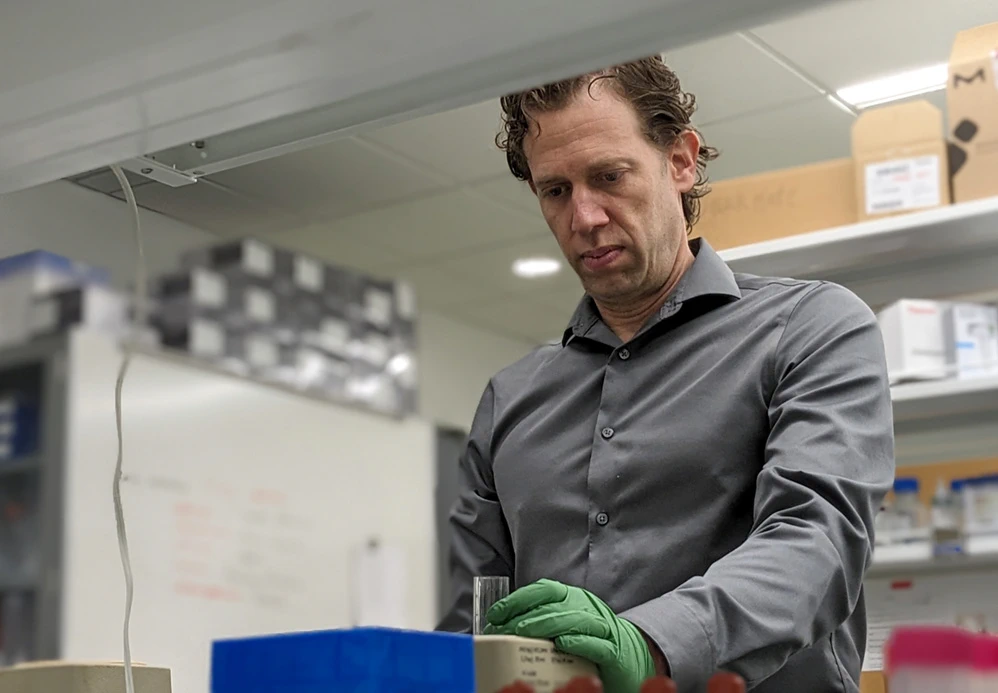Cardiovascular
Ask the expert: What can we learn from links between cancer and heart disease?
“Ask the expert” articles provide information and insights from MSU scientists, researchers and scholars about national and global issues, complex research and general-interest subjects based on their areas of academic expertise and study. They may feature historical information, background, research findings or offer tips.
The world’s leading killers are cancer and cardiovascular disease, which includes heart disease and other issues affecting the heart, blood and blood vessels. In the United States, cancer and cardiovascular disease combined account for nearly 50% of deaths during the first two decades of the 21st century.
Bryan Smith and his team at Michigan State University are using the connections between cancer and cardiovascular disease to help develop therapies and diagnostics for both. Credit: Matt Davenport/MSU
Though these diseases may seem quite different on the surface, researchers, including Bryan Smith of Michigan State University, have recently discovered parallels between their origins and development.
That means that drugs developed to treat one disease could also help fight the other, said Smith, an associate professor in the Department of Biomedical Engineering.
Smith, who also works in the Institute for Quantitative Health Science and Engineering, or IQ, explained how his work and the connections between cancer and cardiovascular disease are creating new opportunities to save lives.
The following Q&A is adapted from an article originally published in The Conversation.
What do cancer and cardiovascular disease have in common?
Although cardiovascular disease and cancer appear to have different origins and causes, they share many risk factors. For example, obesity, smoking, chronic stress, and certain lifestyle choices like poor diet are linked to both diseases.

Red blood vessels and green cancer cells are clearly visible in this microscope image taken by the lab led by Bryan Smith at Michigan State University. But a closer inspection reveals gray specks, which are immune cells carrying nanomedicine cargo that can help them attack tumor sites. Credit: Courtesy of Bryan Smith
Many of the similarities between cardiovascular disease and cancer can be traced to inflammation. Chronic inflammation is a primary cause of atherosclerosis, the deadliest form of cardiovascular disease. The inflammation damages the cells lining the blood vessels and progressively worsens plaques.
Likewise, chronic inflammation can initiate cancer by increasing mutations. Such inflammation can also support cancer cell survival and spread by suppressing the body’s immune response and increasing the growth of the blood vessels that carry nutrients.
How can researchers use those shared features to their advantage?
Research hints that therapies designed for cancer can also help treat atherosclerosis.
For example, there are drugs that target immune cells called macrophages in tumors and cause them to eat cancer cells. It turns out a similar drug can cause macrophages to clear dead and dying cells in atherosclerosis, which shrinks plaques.
Additionally, antiglycolytic therapies that prevent the breakdown of glucose — or sugar, the body’s main source of energy — can make diseased tumor blood vessels and atherosclerotic blood vessels look more “normal,” essentially reversing the disease process in those vessels. They can also reduce inflammation in atherosclerosis.
Sodium glucose cotransporter-2 inhibitors, which are traditionally used to treat diabetes, are another intriguing class of treatments. Researchers have shown that these drugs provide significant protection from cardiovascular disease and can treat cancer.
What are the other practical benefits of investigating therapies and diagnostics that can be used against two diseases?
The costs involved in getting drugs into the clinic are enormous. The possibility of applying the same drug to two different patient populations offers big financial and risk-reduction incentives. It also offers the potential for simultaneous treatment for patients with both diseases.
How is your team contributing to this research field?
A recent discovery showed that nanotubes — very small particles made of carbon that are over 10,000 times thinner than human hair — can go into specific immune cells, travel through the bloodstream and enter tumors as a Trojan horse.

Working with mouse models, Bryan Smith and his team at Michigan State University have developed nanoparticles that respond to light, generating ultrasound waves to reveal vulnerable plaques that can lead to strokes and heart attacks. Credit: Advanced Functional Materials
These nanotubes can carry anything that researchers put on them, including drugs and imaging contrast agents. The immune cells carrying the nanotubes naturally home in on tumors through the inflammatory response.
Because cancer and atherosclerosis are both inflammatory diseases, my research team and I have been studying whether nanotube-loaded immune cells may also serve as delivery vehicles to plaques.
Nanotubes can be loaded with a therapy that stimulates immune cells, or macrophages, to “eat” plaque debris and thus reduce plaque size.
Moreover, restricting drug delivery specifically to those immune cells reduces the risk of off-target side effects. These nanotubes can also be used to improve diagnosis of cardiovascular disease by highlighting plaques using new imaging approaches.
What is your outlook for the role of nanomedicines in addressing cancer and cardiovascular disease?
Nanoparticle-based cancer drugs first entered the clinic in 1995, and researchers have developed many others since. But there is currently only one cardiovascular nanodrug approved by the Food and Drug Administration.
This suggests opportunity for new nanotherapy approaches to improve cardiovascular drug efficacy and reduce side effects.
Because of the parallels between cancer and cardiovascular disease, cancer nanodrugs may be strong drug candidates to treat cardiovascular disease and vice versa. As basic science discovers other molecular parallels between these diseases, patients will be the beneficiaries of better therapies that can treat both.

